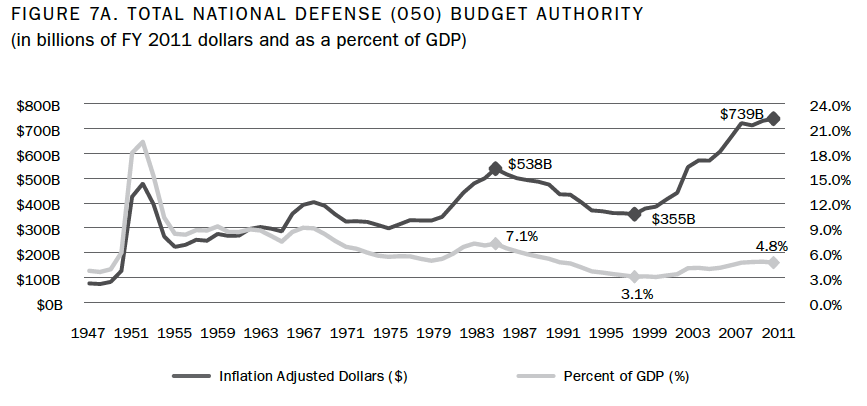The “boom” you just heard coming from the Pentagon isn’t a test of the newest nuclear cannon, but the starting pistol in the race to figure out where — and how deeply — to cut the U.S. military budget. It’s a strange fight to be having as the U.S. military wraps up one war and remains engaged in a second. But with defense spending basically doubling since 9/11 — and now topping the Cold War average — it’s one of the few fat targets left as lawmakers confront economically-stressed constituents demanding they do something about the nation’s soaring deficit. The $700 billion the nation pumps into the Pentagon every year accounts for about half of the nation’s discretionary spending.

Center for Strategic and Budgetary Assessments
The military-industrial complex fears that a widening split in Republican ranks is going to depress defense spending. “A defense budget in decline portends an America in decline,” Rep. Howard “Buck” McKeon, the California Republican expected to be chairman of the armed services committee, said Tuesday. “It will undermine our ability to project power, strengthen our adversaries and weaken our alliances.” But Senator John McCain, Republican of Arizona who served on the Senate Armed Services Committee, said the same day that lawmaker earmarks and over-priced weapons are ripe for trimming. “There’s no doubt that this new group of Republicans have come in with a commitment that would take a weed ax to spending,” McCain said. “I’m not sure that we could say that everything in defense is sacrosanct while the rest of these cuts in education and social programs, etc., are taking place.”
Even centrist scholars of military spending are now suggesting it may be time to take a scalpel, if not a cleaver, to U.S. military spending. “Weighed against the dangers of the fiscal overstretch and economic decline now facing the country, the case for pursuing about a 10 percent reduction in the core defense budget is strong enough to warrant serious consideration in the years ahead,” Michael O’Hanlon of the Brookings Institution wrote Wednesday in the Washington Times. “In debating the idea, we should avoid the implication that there are easy answers or easy economies to achieve, and link possible budget reductions to strategic choices in the nation’s foreign policy.” He argues that shrinking the Army and Marine Corps by about 15 percent, and killing less-needed weapons like the F-35 fighter, the Littoral Combat Ship, the V-22 tilt-rotor aircraft and the Marines’ Expeditionary Fighting Vehicle, make sense.
Defense Secretary Robert Gates knew the gusher was shutting down earlier this year when he called on the military to find $100 billion in savings. His goal: strip that much Pentagon fat and apply it to the muscle to ensure the military can stick to its target of spending 1 percent more than inflation each year. But no sooner had he declared his $100 billion goal than the leaders of President Obama’s National Commission on Fiscal Responsibility and Reform agreed that sum should be cut — and that the resulting savings be returned to the Treasury to reduce the deficit, and not be poured back into military spending. They want to freeze military pay for three years, cut procurement by 15 percent, reduce overseas basing personnel by a third, double Gates’ promise to cut contractors by 10 percent, cut research funding by 10 percent, and reduce out-of-control spending on military health care. On Wednesday, a second group of Washington budget greybeards called for a five-year freeze on Pentagon spending, which would save an estimated $431 billion between 2012 and 2016.
The proposals generated a predictable response. “The truth of the matter is when it comes to the deficit, the Department of Defense is not the problem,” Gates said Tuesday of the commission’s recommendations. “I think in terms of the specifics they came up with, that is math not strategy.” The defense industry recoiled from the very notion. “The highest constitutional responsibility of the federal government is to protect the American people from foreign aggression,” said Marion Blakey, head of the Aerospace Industries Association, a major defense trade group. “The co-chair recommendations in the defense arena, if implemented, would exacerbate the coming shortage of engineers and undercut the capability of the nation’s defense industrial base to design, build and support complex cutting-edge defense systems.”
Of course, it’s those cutting-edge defense systems — to be used against, well, just you wait — that have driven the price of defending this nation into the stratosphere. Check out this price list, released Monday, of all the weapons you’re buying: the bottom line is a cool $1.7 trillion. The very same day, the Pentagon’s top weapons-buyer ordered a new policy to “mandate affordability as a requirement.” Undersecretary of defense for acquisition Ashton Carter’s memo says that cost overruns should be split 50-50 between the government and contractor, and canceled if they rise more than 120 percent above the estimated cost. “You should seek to reduce non-productive processes and bureaucracy in your acquisition process,” he said. Now he tells them.


